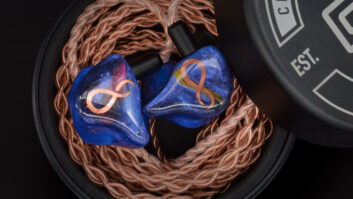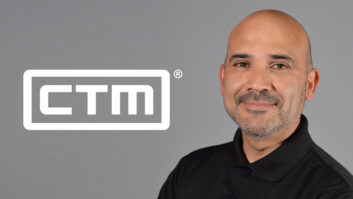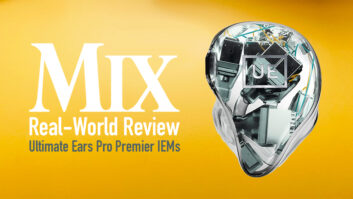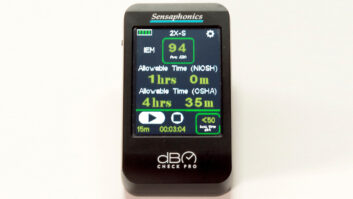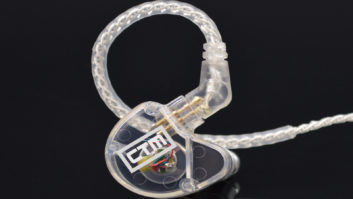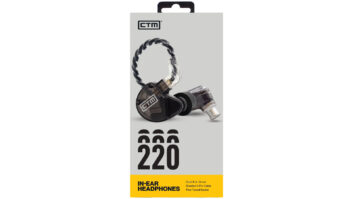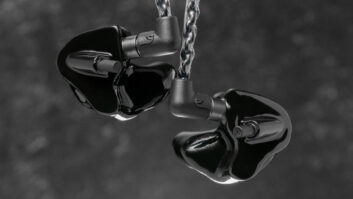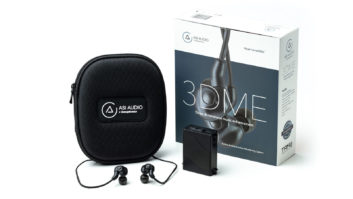In-Ear Monitors (IEMs) offer significant benefits for the performing musician, but they also place higher requirements on users, operators and their equipment. Compared to traditional monitor setups, IEMs require more output mixes, more inputs, more outboard gear and, of course, an individual set of IEMs for each musician and monitor engineer. In order to develop the skills and techniques that provide gratifying results on IEMs, monitor engineers must thoroughly understand the technology and must invest in equipment far more complex and expensive than wedge-based monitoring requires. The payoff is that performers who become comfortable with IEMs may never again be satisfied with wedges.
I’ve been fortunate to learn from some the best IEM engineers and have done a little exploring on my own. I don’t pretend there’s any single best solution to the challenges of this evolving field, but I’d like to share some thoughts with readers who will be using this exciting, new technology.
ONE SIZE FITS ALL…NOT!
Different models of earphones are pleasing to different individuals. There’s no guarantee that any one model will make everyone in a band happy, but for consistency, it is always preferable to use the same model. Also, a close match between the performers’ and engineer’s ear molds is necessary, and the match must be much closer than that between a cue wedge and the floor monitors. Although varying types of monitors can be compensated for, and different sonic characteristics may even be preferable in some situations, the only way to get a good idea of how a performer’s ear mix sounds is to use the same model of earphones. This is not to say that different performers in the same band will be happy with the same response. Not only will tastes differ, but different players’ hearing abilities will vary. (See sidebar on “Healthy Hearing With In-Ear Monitors.”)
Custom molds are more expensive but provide the most comfort and higher isolation. Isolation is important because when the IEMs compete with background sounds, they must be listened to at higher levels. So isolation and hearing conservation go hand in hand. The best earpieces block out ambient sound so that the direct sound can be heard more easily. It is worth repeating that there are no shortcuts to quality. With ear molds, as with most other equipment onstage, you tend to get what you pay for.
ROLL YOUR OWN
One way to “personalize” the response of any given model of IEM is with EQ. In order to equalize IEMs effectively, the engineer needs to become familiar with the response of the product and the hearing of the performers. One way to EQ an IEM mix efficiently is to put the output equalizer controls in the hands of the performer listening to them. Many musicians have a working knowledge of EQ and can quickly make their own adjustments to provide a satisfying mix.
Some headphone enthusiasts recommend what they call “Biphonic EQ,” which amounts to boosts of about 6 dB at 30 Hz, 2.5 kHz and 20 kHz to promote a more natural listening experience. The transducers in many earphones already have a similar boost in the midrange. We’ve seen a simple high-frequency boost available on some IEM products, and it’s conceivable that one of the next features to appear will be the loudness contouring switches that are commonly found on consumer stereos.
THE SILLY-PUTTY METHOD
Many engineers use the SIA Smaart Pro computer-based analysis system for sound-system measurements. I’ve also found this to be a useful tool for comparing the response of IEMs. One standard device is an aluminum 10cc coupler that fits a measurement microphone to a transducer with a chamber that approximates the volume of the ear canal. I’ve discovered that inexpensive couplers can be made from plastic 35mm film canisters (Fuji’s works better than Kodak’s) by drilling a hole in the bottom for a snug fit with the tip of the measurement mic. Lining the inside of the film canister with half-inch foam reduces the size of the chamber to imitate the size and shape of an ear canal, while at the same time reducing reflections. Simply drill a hole in the top of the film container for the tip of the earmold and use a 1-inch doughnut of art clay (or Silly Putty) to seal the ear mold-an airtight seal at both ends is important for accurate readings. You can then measure several molds as quickly as you can switch the tops. This may appear to be a crude measurement method because it doesn’t yield the precise response of the transducer (which varies for different molds and for different ears). It does, however, offer a repeatable means of comparison among different makes, between several units of the same make and, most importantly, for verifying the performance of the same unit over time. I keep several pre-drilled canisters, each drilled out for a different measurement mic, along with a half-dozen tops, all sealed in a plastic bag so the putty doesn’t dry out.
MICS AND GATES
Due to the isolation provided by good ear molds, the ambience of the performance space must be added back to the mix in a controlled fashion for a realistic mix. Conversely, too many open mics in the mix will tend to muddy the sound, and any set-and-forget reverbs on those inputs will mush up the mix even further. For example, a guitar amp pointed at an open vocal mic will wind up in that vocal mic mix, messing up the sound of the guitar in both the monitor and FOH mix. One way to reduce the amount of stage wash getting into open, unused vocal mics is with gates, and one recommended device is the PureSound Mic-Mute, a pager-sized gate that sits on the mic stand and uses infrared light to detect when someone is in front of the microphone. The newest models have adjustable proximity, run on phantom power and offer adjustable attenuation. The traditional Mic-Mute mounts on the back of the vocal mic, but the new MM-4 has an XLR pass-through, allowing it to be mounted lower on the mic stand. The greatest benefit is that the monitor mixer no longer has to spend half the set ducking unused vocal channels, freeing hands for the more important fader moves that IEM mixing demands.
A few extra mics placed in strategic spots around the stage can make it easy for a performer to talk privately to some or all of the band or just the engineer. A gate or Mic-Mute can take the place of a push-to-talk (PTT) switch, making talkback hands-free. In fact, with IEMs, a variety of elaborate communications arrangements can be created, allowing for all kinds of subtle interaction during the show. One example is a simple footswitch that can redirect a vocal mic into a talkback channel. Similarly, the monitor engineer should set up a system for talking to the performers; a PTT is the traditional tool, but a Mic-Mute can free both hands to make adjustments, as the mic will turn itself off when you lean away.
Overhead mics, which were almost never used in traditional stage monitor mixes, now play a significant role in IEM mixes. However, because the sonic image must sit right between the ears, traditional overhead mic placements may not sound quite right for IEMs. Often a single mic over the drummer’s head, a stereo mic or an X-Y pair will provide a better representation of the entire drum kit than the usual split pair of overheads. For downstage audience mics, pencil condensers are generally the most suitable and a stereo mic-such as a Crown SASS or a Shure VP-88-placed downstage center can provide extra realism and imaging that help the artist relate to the audience response.
As an IEM convert, I rarely use a cue wedge anymore, even when an entire band is on wedges, other than during the first half-hour when I’m checking out the rig. I now find that a cue wedge seems to draw posers and hangers-on over to monitor beach, where they interfere with the ability to make meaningful eye-contact with performers. I find it much easier to pick out a speaker mix on the verge of feedback using IEMs, and they can be turned down to a more comfortable level than a cue wedge.
When working as the monitor tech for the artist’s monitor engineer or as the “third guy,” I’ll take the cue out of the console as one input to my wireless IEM transmitter and plug the intercom into the other. This allows me to listen to what the monitor engineer is cueing up, helping me to focus on his/her priorities. It also keeps me apprised of conversations with FOH, where things fall apart first, especially at festivals. And I can go out onstage and troubleshoot while listening to a problem channel or mix that’s cued up on the desk. At the same time, the FOH engineer can talk down the intercom to communicate about what’s happening at the mix position. Another benefit is that wherever I am, people at either end of the intercom can immediately page me without “flashing” by simply calling my name into the intercom.
BETTER COMMUNICATIONS
The most accurate way to monitor a wireless IEM mix is “on-air” via a similar belt-pack and IEM setup, not through headphones and the mixer’s cue bus. The additional cost of a spare belt-pack seems insignificant compared to the crisis that arises when a performer’s mix suddenly “goes down.” The ability to change out belt-packs quickly in an emergency can protect a technician’s sanity and perhaps their job. Other problems, such as the performer leaving the belt-pack (and ear molds) behind (in the limo, dressing room, hotel, etc.) are also avoided by having a spare. When monitoring several wireless mixes, it is not practical to keep moving from one spare receiver to another, and one often needs to solo channels and listen to speaker mixes from the cue output of the console. One solution is a stereo switcher that allows the engineer to select among the various signal paths.
An effective troubleshooting strategy is to use an entire spare wireless IEM system for cueing. This technique provides the same “on-air” response, along with the ability to solo channels and other mixes. An extra belt-pack for this wireless cue system allows the engineer to cue up any troubled mix quickly and hand over the spare with full confidence when moving to a new frequency and hardware. Simultaneously swapping the cue with the troubled mix at the back of the desk allows the operator or assistant to check out the wireless system in question immediately.
STEREO MIXES SOUND BETTER
Stereo IEM mixes allow for a greater variation in mix levels, improve the ability to discern more inputs via panning, provide a greater sense of realism and, most importantly, allow monitoring at lower levels. Spreading instruments across the stereo sound field makes it easier to separate sounds with similar pitch and timbre. Hearing perception is at least 10 dB more sensitive in stereo, so it’s easier to listen and possible to maintain lower levels. However, be aware that in most wireless systems, less-than-perfect stereo separation will bring stereo-panned signals back toward center, a problem that is easily revealed by comparing a wireless IEM with a hard-wired in-ear system.
Guitar players often find the one-dimensional sound of their rig through a single microphone unsatisfying on IEMs. Both Hughes & Kettner’s RedBox PRO and Whirlwind’s Mic Eliminator are examples of active direct boxes with equalization networks that imitate a miked speaker cabinet. Rapco’s DB-101SL is an inexpensive passive DI that has an EQ network and accepts speaker level inputs. In fact, many DIs can accept speaker level inputs as long as they are in parallel with an actual speaker to take up the load, including the ubiquitous Countryman Type 85 (beware the extra switch on the 11/44-inch side that can get you in trouble). When used along with a mic and panned hard, the combination of direct and miked guitar inputs can offer a dimensional quality that not only sounds awesome in the ear mix but is also wide and full over the P.A. Many guitarists are extremely resistant to using direct boxes, so it must be made clear that the goal is to capture the sound after it leaves the warmth of the power amp’s tubes (it doesn’t work as well with solid-state). When they hear this, they’ll understand what they’ve been missing in their ears. Board tapes will also reflect this improvement.
When mixing for IEMs, it’s important to use reverb to create a credible acoustical space, if necessary by adding ambience effects to inputs that would otherwise sound dry through traditional monitor speakers. In fact, much of the challenge of IEM mixing is the creation of “sonic realism.” Fortunately, it’s more of a headphone and earbud world every day, and the IEM world is beginning to enjoy spinoff benefits from the growing general interest in surround sound. For example, a great deal of research has been directed toward 2-channel playback of multichannel sound-AKG’s IVM technology is one result-and there is growing interest in reproducing the Head Related Transfer Function (HRTF) for headphone listening. (HRTF is the term used to describe the phenomenon whereby we localize sound, which depends on natural amplitude and phase shifts caused by the “shadowing” effect of the head. These directional cues for the brain are eliminated when we listen to music on headphones or IEMs, resulting in an auditory image that lacks the third dimension, and the sound mix is firmly localized in the center of the head.) Technologies aimed at the consumer and computer markets are yielding successively better auralization and spatialization that will almost certainly cross over to IEMs in the near future.
Differences in personal ear geometry and varying degrees of hearing ability resulting from the occupational hazards of live sound are factors to consider when selecting in-ear monitors. Consequently, it is strongly recommended that both musicians and engineers get their hearing checked annually.
A hearing test should always be included when impressions are made for ear molds, and both procedures should be performed by a certified and IEM-knowledgeable audiologist. Of course, hearing loss is a sensitive subject among musicians and other audio professionals, and each musician must decide whether to share the results of a hearing screening with the sound engineer. But in the course of learning what different performers want in their monitors, astute engineers will eventually acquire an intimate knowledge of the performers’ hearing anyway. Why not save time? An informed, confidential discussion with your monitor engineer can help conserve your hearing and make it easier for him or her to tailor the mix for your specific needs.
